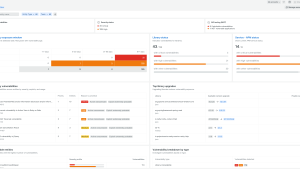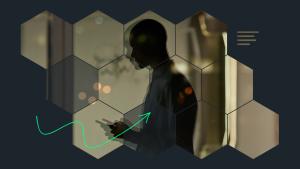In the pulse of the digital era, security takes center stage. Building security into software at every phase of the software development lifecycle (SDLC) is a necessity. Well-defined processes exist for Secure SDLC (SSDLC) to help ensure you think about and execute security practices at every stage – from definition through deployment and maintenance. With this in mind, mature tools are available to simplify your SSDLC journey.
In this article, we’ll look at how you can embed security within your SSDLC and how New Relic interactive application security testing (IAST) helps you achieve a robust SSDLC practice.
What is secure SDLC?
SSDLC is a software development framework that shifts-left security principles, designs, tools, and processes into the SDLC, instead of checking for safe and secure applications at the end. It defines responsibilities, increases visibility, and improves the quality of planning and tracking to reduce risk at every stage of development and deployment. Using an SSDLC framework helps ensure that as your software evolves it remains both innovative and ironclad.
| SW Development Phase | Security Control Shifted Left |
| Requirements | Risk assessment |
| Design | Threat modeling |
| Development | Secure coding standards and practices |
| Verification | Code review, security review, static code analysis, composition analysis, calculated hash, signed code |
| Deploy | Regular scans, third-party penetration tests |
Why is secure SDLC important?
As with any design practice, the cost to fix issues is much higher when they occur later in the development cycle. With the increasing sources of threat vectors for software deployment— publicly available source code repositories, cloud workloads, containerization, and multi-supplier management chains—SSDLC needs to be top-of-mind for any DevSecOps team. Putting SSDLC principles into practice as soon as possible in the design cycle helps:
- Reduce the risk of security vulnerabilities appearing in an app and minimizes impact when they are found
- Improve compliance with regulations and best practices
- Increase customer trust
- Produce more robust applications, lower costs, and quicker deployments
Principles of secure software development
Guided by steadfast principles, secure software development becomes an art form. Let’s delve deeper into them.
Least privilege: This principle is about minimalism—grant only the permissions necessary for users (or systems) to accomplish their tasks. Regularly review and adjust these permissions to prevent unnecessary access, reducing the potential for misuse or exploitation.
Data protection: In an age where data is gold, safeguarding it is paramount. This involves encryption, secure data storage, and stringent access controls. Think of this as building an impenetrable vault for your valuable data.
Regular audits: Like a health checkup for your software, regular security audits allow you to identify potential weaknesses before they can be exploited. This is your chance to be proactive, catching issues before they become full-blown problems.
Secure coding practices: Train developers to write code with security at the forefront, using techniques that prevent common vulnerabilities like SQL injection, XSS, and CSRF attacks.
Open communication: Encourage a culture where security is everyone’s responsibility and questions or concerns can be raised openly without fear of blame.

Secure SSDLC process and phases
An SSDLC framework integrates security at every stage of software development. Here are the phases broken down:
Foundation phase, requirements: This phase is about defining the security objectives and requirements that your software must meet. This is the time for asking, "What are our security goals, and how will we meet them?"
Blueprint phase, design: In this phase, security architecture is developed. Think of this as the blueprint for your application's security, outlining how key components will interact while maintaining integrity and confidentiality.
Crafting phase, implementation: Here, developers write code with security in mind, adhering to the secure coding practices established in earlier phases. This phase is the heart of the development process, where secure principles become secure actions.
Assessment phase, testing: Security isn't something you can “set and forget.” Regular, rigorous security testing should be performed to identify and fix vulnerabilities. This is where tools like New Relic IAST shine, offering deep insights into potential security issues.
Launch phase, deployment: As your application is released into the wild, security controls must be in place to protect it in its live environment. This is the moment of truth—when your preparation is put to the test.
Guardian phase, maintenance: Security is an ongoing commitment. This phase involves continually monitoring, updating, and patching your software to respond to new security threats and vulnerabilities as they emerge.
The intersection of secure software development and application security
When secure software development meets application security, it’s a symphony of proactive and reactive measures working harmoniously. This is where security becomes a continuous, integral part of development, not just a final checkpoint. Think of it as building a house with strong materials from the start, rather than adding locks and alarms after it’s built.
Starting with a secure foundation
At the core, secure software development is the act of writing code with security built into every line. It’s choosing the strongest and most reliable materials for your house. Application security, on the other hand, is the practice of applying additional layers of protection to an already developed application. This is akin to installing advanced lock systems, motion detectors, and security cameras around your house. They are important and powerful, but they work best when the house itself is built solidly.
Continuous and integrated vigilance
In this harmonious interaction, security measures are integrated into the development process from day one. Code is written, tested, and rewritten with security in mind, which means potential vulnerabilities can be spotted and addressed in real time, rather than after the fact. It’s a live security concert that plays throughout the entire development process. Imagine having seasoned architects and security experts planning the layout of your house together, advising on the best materials, construction techniques, and security measures from the beginning.
Feedback loops that inform and empower
In this intersection, developers are not left in the dark; they receive immediate and actionable feedback about potential security issues. Tools like New Relic IAST work in concert with your development activities, illuminating potential weak points and suggesting solutions before those weaknesses can be exploited. It’s as if, while building that house, the materials themselves could tell you when they were placed under undue stress and suggest ways to reinforce them.
Turning reaction into proaction
In the past, security was often a reactionary measure—a response to threats as they arose. Today, the blend of secure software development and application security transforms this narrative. Security measures are woven into the daily rhythms of development. Every decision is made with security in mind, turning a once reactive necessity into a proactive strategy.
Scaling with grace and intelligence
As applications grow, so too do their potential vulnerabilities. By integrating secure software development practices with application security measures, businesses are not just scaling their applications; they are scaling their security capabilities as well. In our house analogy, it’s planning for future additions—perhaps a new wing or floor—and understanding how these changes will interact with the current security infrastructure.
In this united approach, security is not a hurdle to clear at the finish line; it's a constant companion throughout the journey, ensuring that as your software evolves, its defenses evolve right alongside it. It’s an ingenious strategy, not just for surviving in today’s digital landscape, but for thriving in it. The New Relic observability platform, with its 30+ capabilities—including interactive application security testing (IAST)—is an integrated, continuous, and intelligent approach to security that isn’t just a theoretical ideal—it’s today’s reality.
Aligning with the OWASP SSLDC
When it comes to security, guidance from trusted sources is invaluable. The Open Web Application Security Project (OWASP) is a respected authority in the world of software security. Its SSDLC framework is a comprehensive roadmap designed to guide you in the integration of security into your software development process.
OWASP's wisdom for secure development
OWASP is not just about tools and resources; it's a philosophy built on foundational principles that guide secure software development. At the core of OWASP's approach is the belief that security should be integrated into every phase of software development. This means prioritizing proactive measures, such as rigorous code review and threat modeling, to identify and mitigate vulnerabilities before they can be exploited. It also means empowering developers with the knowledge and tools they need to write secure code from the start, thereby reducing the risk and cost associated with addressing security issues after deployment. OWASP advocates for transparency, encouraging the sharing of security knowledge within the community, so everyone can benefit from collective insights and experiences. In essence, OWASP’s principles are designed to foster a culture where security is a shared responsibility that’s embraced by developers, security teams, and organizational leaders alike.
Secure software development best practices
Follow these best practices for secure SDLC:
Early integration: Security should be a consideration from the start of a project, not just a phase at the end. Integrating security into each stage of the secure development lifecycle ensures vulnerabilities are addressed proactively and makes it a natural, seamless aspect of development.
Continuous testing: Make security testing a core component of your continuous integration/continuous deployment (CI/CD) pipeline. This ensures that security is assessed regularly and automatically, not just at project milestones.
Education and training: The security landscape is always evolving, and your team should evolve with it. Regular secure development lifecycle training sessions can keep everyone up to date on the latest threats and best practices and ensure that security awareness is a fundamental part of development culture.
Collaboration and communication: Security is a team sport. Encourage open dialogue between development, security, and operations teams. This collaboration can illuminate potential issues before they become problems.
Automate where possible: Use tools to automate repetitive and time-consuming tasks, such as code scanning and vulnerability assessments. Automation is a key component of best practices for secure software development, helping your team focus on what they do best: building great software.
Empowering developers to build security into their software from the get-go is more than a best practice—it’s an absolute necessity in today’s digital landscape. With the New Relic observability platform, developers are not only equipped to meet this challenge but to excel at it, creating software that’s as secure as it is powerful.
The challenges of secure software development (and how to solve them)
Challenge 1: Resource strain
Problem: Integrating security measures can be time-consuming and may require specialized skills that your current team doesn't possess. This can lead to delays in the project timeline and additional costs for hiring security experts.
Solution: Automate security testing where possible. Capabilities like New Relic IAST can perform continuous, automated security assessments, enabling your team to identify and address vulnerabilities as they develop, not after the fact. This not only saves time but also allows your existing team to focus on what they do best.
Challenge 2: Complex regulations
Problem: The landscape of data privacy and security regulations (such as GDPR, CCPA, HIPAA) is complex and ever-changing, making compliance a moving target that’s hard to keep up with.
Solution: Establish a dedicated role or team responsible for staying current with relevant regulations and ensuring that your projects remain in compliance. Regular training and updates for the entire development team can turn compliance into a routine part of the process, rather than a scramble to adapt when new regulations are enacted.
Challenge 3: Cultural resistance
Problem: Not all teams are accustomed to security-first thinking, and there may be resistance to adopting new processes that are perceived as burdensome or slowing down development.
Solution: Foster a security-focused culture from the top down. Regular training and an open dialogue about the importance of security can help. Celebrate and reward secure coding practices and make security a key performance indicator (KPI) for your development teams. When security is valued and rewarded, it becomes a point of pride rather than a perceived burden.
Challenge 4: False positives
Problem: Security tools can sometimes generate false positives, which can lead to developers becoming desensitized to alerts, potentially overlooking genuine vulnerabilities.
Solution: Choose security tools, like New Relic IAST, that are designed to minimize false positives. Regularly review and fine-tune the configurations of your security tools to ensure they are as accurate as possible. This keeps your team focused on genuine threats, not chasing down endless false alarms.
Challenge 5: Balancing speed and security
Problem: In today’s fast-paced development environment, there’s constant pressure to release quickly. Security measures can sometimes be perceived as slowing down this process.
Solution: Integrate security into the DevOps process (DevSecOps), making it a seamless part of the CI/CD pipeline. This way, security checks become a routine part of the process, not a separate phase that delays release. Capabilities like New Relic IAST can be integrated directly into your CI/CD pipeline, providing real-time feedback without slowing down development.
In the face of these challenges, the key is to view security not as a hurdle, but as a vital aspect of quality software development. By equipping your team with the right tools, knowledge, and culture, you can turn these challenges into opportunities for growth and excellence.
Crafting a secure software development framework
Crafting a secure software framework is a pivotal step towards ensuring that security is woven into the fabric of your development process. framework provides a structured approach, incorporating policies, best practices, and security controls to guide teams throughout the software lifecycle. It serves as a blueprint that clearly outlines the organization’s expectations, protocols, and standards for security throughout the development lifecycle. Define goals, involve stakeholders, harness cutting-edge tools, and ensure evolving education. With such framework , you’re not merely reacting but thriving with assurance.
Introducing New Relic IAST
With New Relic IAST, empower your SDLC. Imagine having an omnipresent security maven, spotlighting vulnerabilities and guiding towards unparalleled software robustness. Welcome to the future of development.
Next steps
Learn more about New Relic IAST.
Sign up for a free account today to take advantage of IAST and the 30+ other capabilities of the New Relic platform. Your free account offers 100 GB/month of data ingest, one full-platform user who can use all of our tools, and unlimited basic users who can view your data and insights.
The views expressed on this blog are those of the author and do not necessarily reflect the views of New Relic. Any solutions offered by the author are environment-specific and not part of the commercial solutions or support offered by New Relic. Please join us exclusively at the Explorers Hub (discuss.newrelic.com) for questions and support related to this blog post. This blog may contain links to content on third-party sites. By providing such links, New Relic does not adopt, guarantee, approve or endorse the information, views or products available on such sites.



